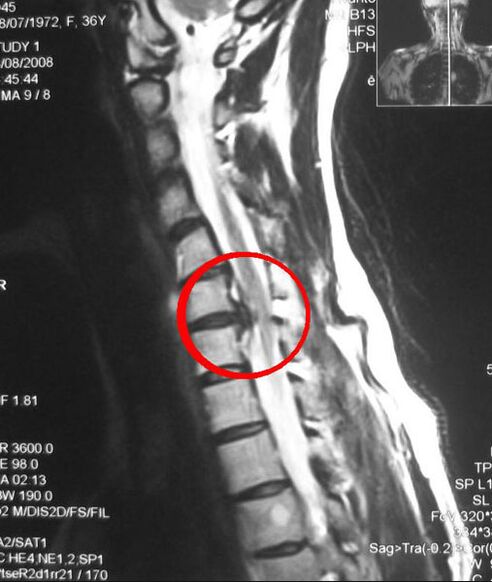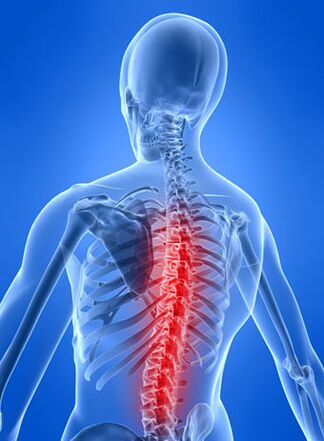The thoracic form of osteochondrosis is characterized by degenerative damage to the intervertebral cartilage and secondary changes in the thoracic spine. Diagnosis of the disease is sometimes quite problematic, because it is often "masked" as other pathologies: myocardial infarction, angina pectoris, pathologies of the gastrointestinal tract.
Features of thoracic osteochondrosis
This type of disease is quite rare in the cervical and lumbar region.
The reason lies in the peculiarities of the anatomical structure of the chest region:
- It is the longest (consists of 12 vertebrae);
- In this area, a slight natural bend appears - physiological kyphosis, which relieves part of the load as a result of vertical walking;
- The chest area is articulated with ribs and sternum, which perform the functions of the physiological frame and receive the main load;
- In the cross-section, the dorsal canal of the thoracic duct has the smallest dimensions;
- Thoracic vertebrae are thinner and smaller in size, but have long pointed processes.
As a result of these factors, the thoracic part is not particularly mobile, so osteochondrosis in this part of the spine is rare, but its symptoms are quite pronounced: it is a rather strong and unpleasant pain associated with the stretched nerves of the back, which irritates the shoulder. Belt and upper limb organs located in the abdominal cavity and chest. For the same reasons, the manifestations of the thoracic form of osteochondrosis are often atypical, which significantly complicates the diagnosis of the pathology and further treatment.
The narrowness of the spinal canal, the presence of physiological kyphosis and the relatively small size of the vertebrae create the most favorable conditions for the formation of intervertebral disc herniation. Since a significant part of the load mainly falls on the anterior and lateral parts of the vertebral bodies and discs, the disc is pushed back and a disc herniation, or Schmorl's hernia, occurs.
The front of the spine is subjected to greater stress than the back. For this reason, very often osteophyte growth and intervertebral disc prolapse occur outside the spinal column and do not affect the spinal cord.
Stages of thoracic osteochondrosis
Manifestations of thoracic osteochondrosis are determined by the changes in the discs and vertebrae, depending on the four main stages of the disease:
- Stage I is characterized by dehydration of the intervertebral discs, as a result of which they lose elasticity and strength, but still maintain a normal load. The process of flattening of the disk begins, its height decreases and a bulge is formed. The pain is mild at this stage.
- In stage II, cracks are formed in the fibrous ring and the instability of the whole segment is fixed. Painful sensations become more intense and stronger during bending and some other movements.
- A characteristic sign of stage III is the rupture of the fibrous ring and the beginning of the formation of intervertebral disc herniation.
- When moving to stage IV, due to the lack of resistance of the disc, the vertebrae begin to approach each other, which provokes spondyloarthrosis (defects in the intervertebral joints) and spondylolisthesis (twisting or displacement of the spine). The mobilization of compensatory forces to reduce the load leads to the growth of the spine, the increase in its area and flattening. The affected part of the fibrous ring begins to be replaced by bone tissue, which significantly limits the motor capabilities of the section.
Grades of thoracic osteochondrosis
Today, many specialists use a different classification principle, according to which the course of osteochondrosis of the thoracic spine is distinguished not by stages, but by the degree of their characteristic features.
How is the primary disease manifested? As a rule, it is diagnosed when the intervertebral disc ruptures, which is caused by excessive load or sudden movement. In this case, a sharp pain suddenly appears in the spine. Patients compare it to the passage of an electric current through the spine. This condition is accompanied by reflex tension of all muscles.
The second degree of thoracic osteochondrosis is discussed in cases where instability of the spinal column appears and symptoms of protrusion of the intervertebral discs develop. This condition is extremely rare, is characterized by periods of exacerbation and subsequent remission, and is detected only by a thorough diagnostic examination.
What are the symptoms of third degree disease? The pain becomes constant, radiates along the damaged nerve and is accompanied by a partial loss of sensation in the upper or lower limbs, a change in gait and an intense headache. At this stage, difficulty in breathing and disturbance of the normal heart rhythm are often observed.
We can talk about the transition to the fourth degree, when the manifestations of the disease decrease, and the symptoms of instability of the spine continue (slipping, twisting of the spine, fixation in relation to each other). Osteophytes begin to grow, gradually compressing the spinal nerves and compressing the spinal cord.
Typical symptoms and signs
Osteochondrosis of the chest region has quite characteristic signs, on the basis of which it is possible to diagnose this disease:

- Intercostal neuralgia - often the pain is localized in one area, after which it quickly spreads to the entire chest, forcing the patients to be in a certain position and greatly complicates breathing.
- When turning, moving the neck, bending over, raising the arms, breathing acts (inhalation-exhalation), the pain becomes much more intense.
- Middle and upper back muscles experience a strong spasm. It is also possible to contract the muscle fibers of the abdomen, back and shoulder girdle, which is of a reflex nature (develops in response to an acute pain syndrome).
- Intercostal neuralgia is often preceded by pain, stiffness, and discomfort in the chest and back when moving. The pain can be quite intense and can last for several weeks without further spread, after which it gradually disappears.
- All symptoms are more pronounced at night. In the morning, they are significantly softened or reduced, aggravated by hypothermia, movements (especially vibratory and sudden), and may be manifested in the form of some stiffness.
Atypical symptoms and signs
Often the symptoms of osteochondrosis localized in the chest resemble other diseases.
- Imitation of pain characteristic of heart pathologies (heart attack, angina pectoris). Such pain can be quite long (unlike cardialgia), and traditional drugs used to dilate coronary vessels do not relieve pain. Cardiogram also shows no changes.
- In the acute stage of thoracic osteochondrosis, long-lasting (up to several weeks) pain in the chest often appears, which is reminiscent of diseases of the mammary glands. They can be excluded by examination by a mammologist.
- Pain in the abdomen (iliac region) resembles colitis or gastritis. When localized in the right hypochondrium, cholecystitis, pancreatitis or hepatitis are often mistakenly diagnosed. Such symptoms are often accompanied by disruption of the digestive system due to damage to their innervation. In such cases, it is necessary to identify thoracic osteochondrosis as the primary disease that causes such manifestations.
- If the lower part of the chest is damaged, the pain is concentrated in the abdominal cavity and simulates intestinal pathologies, but there is no connection with the quality of food and diet. The severity of pain increases mainly due to physical activity.
- Disorders of the reproductive or genitourinary system also develop as a result of organ innervation distortion.
- Damage to the upper segment of the chest region causes symptoms such as pain in the esophagus and pharynx and the sensation of a foreign body in the pharyngeal cavity or retrosternal region.
Atypical symptoms are characterized by late afternoon manifestation, absence in the morning and exposure to provoking factors.
Dorsago and dorsalgia

Signs of thoracic osteochondrosis include two spine syndromes:
- Dorsago
- Dorsalgia.
Dorsago is a sudden, sharp pain in the chest, usually when standing up after sitting in a bent position for a long time. The intensity of pain can be so high that it is difficult for a person to breathe. In this case, there is significant muscle tension and limited range of motion in two areas: cervical and thoracic.
Dorsalgia is characterized by gradual, imperceptible development. The severity of the pain is insignificant - sometimes it is more a feeling of discomfort than a pain syndrome. Main features:
- Duration can be up to 14-20 days;
- Intensification of the syndrome is observed when bending to the sides, moving forward or deep breathing;
- Upper dorsalgia restricts movements in the cervical area, lower dorsalgia restricts movements in the lumbar-thoracic area;
- The pain worsens at night and may disappear completely when walking;
- Increased pain is provoked by deep breathing and staying in one position for a long time.
diagnosis
To confirm the diagnosis, the following is performed:
- Radiography. With its help you can discover:
- changes in the anatomy of the damaged segment;
- disc thickening;
- deformation and displacement of the spine;
- The difference in the height of the intervertebral discs.
- Computed tomography (CT) and magnetic resonance imaging (MRI) are more accurate methods because they provide a layer-by-layer image of the damaged area.
- Electromyography is performed to differentiate neurological symptoms that develop as a result of compression of the nerve roots of the thoracic type of osteochondrosis. Examination is indicated if the following signs are present:
- Violation of coordination of movements;
- headache;
- dizziness;
- pressure fluctuations.
- Laboratory tests - performed to determine blood calcium levels and ESR (erythrocyte sedimentation rate).

























